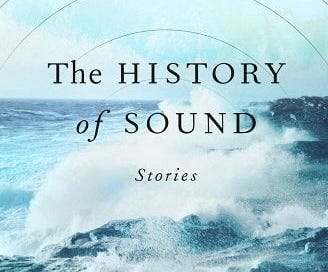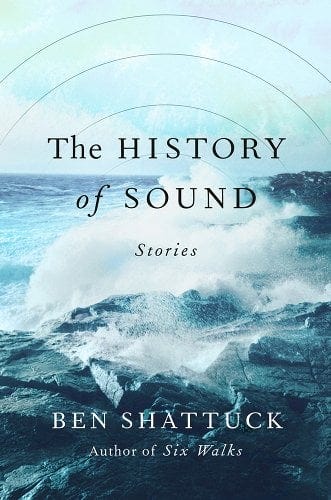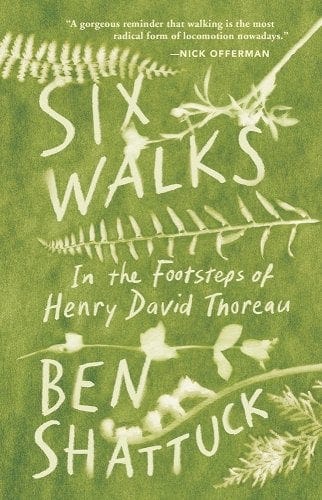Ben Shattuck’s The History of Sound is just a terrific collection of short stories that I was so struck by, I read the book twice in succession. I explained why in some detail in my review at the Chicago Tribune, but mostly it was because I was not ready to leave the world that he conjured.
The Trib only gives me 600 words to work with each week, so I knew I wanted to be able to share more about this remarkable book. What better way than to go to the author himself with some of my questions about the book’s origins and construction?
John Warner: I’m curious how you describe the connections between the stories. It’s not a “novel in stories,” though as I say in my review, I thought the book delivers some of the pleasures of short stories and a novel combined. “Linked” short stories always sounds vague to me. The word that came to my mind to describe the relationship among the stories is “braided.” How do you think of the stories in relationship to each other?
Ben Shattuck: Every story in this collection has what I’ve been calling either a ‘sister story’ or ‘companion story’ or ‘counter story.’ Whatever the exact wording is, it all gets at the same thing: these are paired stories, instead of broadly interconnected stories, to reflect the specific one-two relationship I see in the way we treat history — in research, academics, historical nonfiction, historical fiction, family history, and so on. Like, there’s the person in the present writing about or discussing the past, and then there’s the past itself (person, event or place) that the writer resurrects. The instruments of that resurrection are research and the writer’s capacity to empathize across large gulfs of time. Suddenly, a duet forms, a naturally paired relationship. From that duet, a harmony might build between the story in the past and the story in the present, a sort of third ‘note’ that is something larger than either story. Another way to describe that harmony is an understanding of stories outside their times, something like insight or perspective. Each story offers something to its ‘sister’ — through a plot point or a revelation or an inverted theme — that, I hope, comes closer to that harmony I’m reaching for. Sometimes each story holds a secret about the other, that the reader will only fully understand when read as a pair. Other times, each story poses the same question but answers it in two different ways. Like, The History of Sound explores the deep regret of not staying with your first love, and its pair, Origin Stories, explores the deep regret in staying with your first love, and so forfeiting an independent life.
I’m fascinated by that duality — and historical fiction in general — because of the surprising effect that writing about the deep past has on the present. The farther back in time you go, the more contemporary life you have to strip away. Gone are the cell phones, emails, and cars, the trains, lightbulbs, antibiotics, newspapers, and so on. You go down and down, stripping away, and what you have left, most of the time, is two people in a dark room lit by candlelight, exploring only their relationship and feelings about each other or themselves. You can reach a sort of minimalist quality in historical fiction. Then this surprise happens: you see that the relationships and feelings of characters from the past, even when stripped down, are still, simply, the same as ours. If you feel close to those characters (as I do when I’m writing about them), but understand how far away they are, you might experience a sort of intimacy about a shared human experience. Does this make sense? That writing about history can illuminate clear ahistorical feelings? That across time we’re asking the same questions, feeling the same pain or euphoria or jealousy, which might make someone in the present, reading this invented story, feel more connected to the pool of timeless human experience.
JW: A number of these stories have been previously published serially, and over a fairly good stretch of years, so they definitely stand alone. Did you always conceive of them being part of a large whole, or did that develop over time?
BS: The short answer is that the paired concept developed over time, naturally, almost in the same way plots develop. I don’t think it’s wrong or hyperbolic to say that writers often catch up to their own plots, that you start with character or place, then feel into the story, then change and tighten the story, then change and recombine the characters. It’s a process of growth instead of outlining.
The first story to inspire a pair was “Edwin Chase of Nantucket.” The whole story takes place over a single night in 1796, when a portrait painter arrives on a farm in Nantucket to visit his first love, Laurel, who is the mother of the protagonist, Edwin. Over the course of the night, Edwin gains an understanding of his mother’s past life. The next morning, the artist leaves a small painting for Laurel on the mantel. Later, as I was writing a story about an art student in present day moving to Nantucket, I had that painting in the back of my mind. I knew it would show up in this new story, and it made me think about all the others, how I could also pair them.
Some of the stories have a strong link — like, one story is formatted as a Radiolab episode responding to a story about a man ‘discovering’ an extinct bird in Newfoundland. Another is an ‘introduction’ to a fake historical book about a 17th century cult, which is preceded by the story of the cult from the perspective of one of its members (in both these pairs, you discover some secret about the other story). Those very specific pairs, unsurprisingly, were the last ones I wrote, when the format of the book was well established. And maybe that’s a good way to explain it — the more directly in conversation the stories are, the likelier they are to have been written later in the process. The title story, “The History of Sound,” is the oldest story in this collection, written in graduate school, and its companion, “Origin Stories,” is the last one I wrote, and also the final story in the book.
JW: Your first book, Six Walks: In the Footsteps of Henry David Thoreau was literally built around a kind of fieldwork - you being in the world observing, thinking, feeling - but it also required research as a kind of grounding to that fieldwork. You cite some of the books you turned to in working on the stories in The History of Sound, but you are also literally rooted in the places you’re writing about. How do you think about the combining of observation and research as you develop these stories?
BS: Observations within landscape is the foundation of this book — just like Six Walks. (As a side note, this book is enormously influenced by Transcendentalist thinking, where revelations, plot changes, and character developments happen mostly when the landscape is working on characters.) The great thing about placing stories set in the deep past within nature (instead of a city) is that landscape doesn’t change that much. Like, in one story, a character from the 18th century looks up to see chimney swifts (a swallow like bird) arcing over his house — which is something you can see today; or, in another story, a woman in the 1880s describes the way a coastal storm swipes away a clear day and brings in snow nearly out of season, just like I’ve seen here from my house on the Massachusetts coast. All to say, nature is a stage large enough to fit characters across sweeping stretches of time; to accurately describe it now is to accurately describe back in time. The sound of the wind over a weather-beaten house on Cape Cod is the same, as with the smell of rain on stones, or noticing the way snow passes through winter-stripped trees, and so on. Thoreau’s observations about nature are stunning and perfectly observed (especially his journals), but they are also timeless. You can see what he wrote about the first leaves of an oak tree in the spring 1854 and see that exact thing in the spring of 2024.
As for research from books: in a way, that’s the inverse of fieldwork. While I’m infusing historical fiction with as much concrete, sensory-based description of nature, I’m trying to, in a way, subtract book-based research that might distract from the character. As in, it’s important to not make the story feel like a report about the 18th century, with an inventory of tools and utensils, or descriptions of cultural habits or ways of living or eating or dressing that would appeal to a modern audience but would be irrelevant or unimportant to a character in the past. I use book research to make sure I don’t include anachronistic details — but I rarely use research to build out a story. Like, for the Journal of Thomas Thurber, I needed only to figure out what lumbermen in the early 20th century would eat and how they would cut down trees and haul them away — which is a very small amount of research. The ‘research’ for rest of the story is mostly my observations about being in the northern woods on a frigid winter day, about my teenage years spent in a boys’ dorm in a New England boarding school and what young male violence looks like, about what it’s like to leave your partner after a fight and the regret and pain that seeps in, and all the stuff you would’t find in a book about lumbering in 1908.
JW: I’m wondering if you were thinking about genre at all with some of the stories. “The Journal of Thomas Thurber…” reads like a ripping horror story. “Radiolab: Singularities,” which takes the form of the first segment of the popular public radio show, and “Introduction to The Dietzens: Searching for Eternity in the North American Wilderness, which is written as an introduction to a scholarly monograph, take on frames that remove them from being read as straightforward (for lack of a better word) traditional stories. Does the form come and then the material, vice versa, or is it something else?
BS: The form usually came first, then the material that would best suit it. For instance, I love reading nonfiction history, and I noticed a peculiar thing in the past decade or so, in which (some) author introductions were becoming increasingly personal, increasingly author-centered. Sometimes the author would qualify their role in the work, their authority to tell the story, or try to explain something away. These introductions seemed to border on apologetic or so overdone or self aware that I soon became fascinated with them. What is motivating these authors to write these? Editors? A natural progression in historical writing? Anyway, I knew I wanted to replicate one, and so looked around one of my stories that would be easiest to ‘write about’ in a fake historical text: “The Children of New Eden” was the obvious choice, and so “Introduction to ‘The Dietzens: Searching for Eternity in the North American Wilderness” was my response. The same can be said about Radiolab — I was interested in the form first, the way podcasters sometimes descend on a story or town to retell the story, and then looked around for the best short story to respond to, which was, of course, “The Auk.”
JW: How much Radiolab did you listen to for that story? You really nail the show’s cadences, and full disclosure, some of the quirks that sort of drive me crazy in how they unspool their narratives. The story that follows, “The Auk” could have stood alone without the priming of “Radiolab: Singularities” but I found the pairing very satisfying.
BS: I love Radiolab — and listen to it all the time. This definitely plays with the show, but I hope not in a mocking way. I could have written a This American Life episode, and the things the podcaster got ‘wrong’ (as the Radiolab episode does) would have just been framed a little differently. I’m mostly interested in how astoundingly popular audio storytelling is — as in, the explosion of podcasts. My Radiolab piece only functions because I had bet that most readers of the book would have heard a Radiolab episode, and they might be able ‘hear’ the episode as they read. If I had, say, written a transcription of This American Life as a story, all the work of character description for Ira Glass would be complete by simply writing, “Our show today in three acts…”
JW: Your bio says you own and run the “oldest general store in America?” How does one become the proprietor of such a place, what is the day of a general store owner like, and what’s the oddest thing I might find in your store?
BS: I had been living in Amsterdam for a couple years before I met my wife, Jenny. When I moved back to Massachusetts, I missed the Dutch pub as a gathering place after work, for people on their way home — so, I went looking for a place where I could open a country pub. Davoll’s General Store — built in 1793 — is just down the road from us, where my brother and I used to go for penny candy and where my great-grandmother bought cheese and molasses and dry goods. I was talking to the owners one day, about how I just wanted to create a gathering space for the community like I’d seen in Holland, and they said, “Well, why don’t you make us an offer.” So, I called my brother, and he and I bought it together — opened a bookstore, a pub, expanding the local grocery section and the kitchen, and added here and there. I used to do a lot more day to day, years ago, but now the store’s manager, Mary Ann, runs the place. An old New England general store is like a 19th-century mall, and there are a lot of pieces and managerial tasks that need constant attention. Years ago, I might be at the store with a drill in one hand, hanging up a sign, a phone in my other hand, on hold with the insurance company, and wishing I could be home at the writing desk. Now, I stop by for coffee, say hello to all the lovely employees, look at all the new books, and just relish in the joy of having a place where I run into my neighbors. As for the oddest thing in the store… maybe the bundles of peach tree wood that a neighbor drops off for us to sell? Or the giant antique glass buoy?
Previous recent author Q&A’s:






Wow, this looks great and I love the idea of sister stories. Definitely putting The History of Sound on my TBR list. Thanks for the interview!
I just finished reading The History of Sound. I loved every minute of it! Such a great idea for a collection of short stories. Thanks for sharing this interview, which led me to pick up Shattuvk’s book.